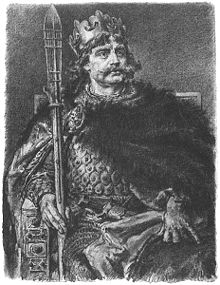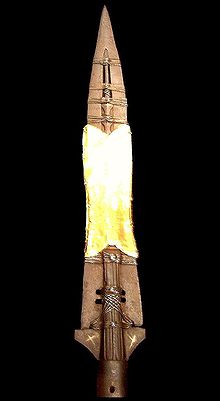| Revision as of 16:52, 27 September 2008 edit71.137.197.97 (talk) add.← Previous edit | Revision as of 09:39, 28 September 2008 edit undoMolobo (talk | contribs)13,968 edits neutralising, Adalbert was not the first, Cyril was, Poland was created in 966, added citations, removed text that was opinionNext edit → | ||
| Line 6: | Line 6: | ||
| ] ]] | ] ]] | ||
| The '''Congress of Gniezno''' ({{lang-de|Akt von Gnesen, Gnesener Übereinkunft}}, {{lang-pl|Zjazd gnieźnieński}}) took place on ] ] |
The '''Congress of Gniezno''' ({{lang-de|Akt von Gnesen, Gnesener Übereinkunft}}, {{lang-pl|Zjazd gnieźnieński}}) took place on ] ]. Scholars disagree over the details of the decisions made at the meeting, especially whether the ruler of Poland was pledged the king's crown or not. | ||
| After his death in ] AD in ], ] was soon made a ] by the common effort of ] and ] |
After his death in ] AD in ], ] was soon made a ] by the common effort of ] and ]. His body, bought by Boleslaus I for its weight in gold, was put into the tomb in ], contemporary capital of ]. | ||
| Otto III committed to a ] to St. Adalbert's tomb in Gniezno in his attempt to extend the influence of ] in Eastern Europe, and to renew the Empire based on a federal concept ("''renovatio Imperii Romanorum''") with the |
Otto III committed to a ] to St. Adalbert's tomb in Gniezno in his attempt to extend the influence of ] in Eastern Europe, and to renew the Empire based on a federal concept ("''renovatio Imperii Romanorum''") with the Poland and Hungarian added to Empire as duchies and upgraded to eastern ''federati'' of the empire<ref name="Lawaty">Andreas Lawaty, Hubert Orłowski, ''Deutsche und Polen: Geschichte, Kultur, Politik'', 2003, p.24, ISBN 3406494366, 9783406494369</ref>. As part of this policy he also invested ] of ] with the king's crown. The dynasty of ] under ] which ruled Poland managed to gain the title and position as duke from the empire under margrave ] and from the emperors ] and ]. | ||
| In ] A.D, while on the ], ] invested Duke ] with the titles ''frater et cooperator Imperii'' ("Brother and Partner of the Empire") and ''populi Romani amicus et socius''<ref name="Lawaty"/>. On the same visit, Otto III raised Gniezno to the rank of an ]. By this nomination Poland was kept separate from the ], the nearest German ecclesiastical province. Bishopric of |
In ] A.D, while on the ], ] invested Duke ] with the titles ''frater et cooperator Imperii'' ("Brother and Partner of the Empire") and ''populi Romani amicus et socius''<ref name="Lawaty"/>. On the same visit, Otto III raised Gniezno to the rank of an ]. By this nomination Poland was kept separate from the ], the nearest German ecclesiastical province. Bishopric of Poznan had since its establishment been assigned to archbishopric of Magdeburg, to which it was still confirmed by the pope in the 12. century{{fact}}. Emperor ], father of ], had died at age 28 in 983 AD and his widow ] and grandmother had reigned for the child-king Otto III. By the year 1000 AD at Gniezno Otto III was 20-years old, he died in 1002. Creating the seperate archdiocese Gniezno resulted in keeping Poland independent from the ] through the ]. | ||
| Three new dioceses subordinate to Gniezno were created: in ], ] and ]. ]'s brother ] became the first archbishop of Gniezno. Otto III gave Boleslaus a replica of his ], and Boleslaus presented the Emperor with a ], an arm of St. Adalbert in exchange. | Three new dioceses subordinate to Gniezno were created: in ], ] and ]. ]'s brother ] became the first archbishop of Gniezno. Otto III gave Boleslaus a replica of his ], and Boleslaus presented the Emperor with a ], an arm of St. Adalbert in exchange. | ||
| Line 18: | Line 18: | ||
| The event was described by German chronicle writer ] and ], the first author of Polish history. | The event was described by German chronicle writer ] and ], the first author of Polish history. | ||
| Due to Otto's early death in 1002, his ''renovatio'' policies were not fully applied. ], Otto's successor, changed the empire's policies |
Due to Otto's early death in 1002, his ''renovatio'' policies were not fully applied. ], Otto's successor, changed the empire's policies which founded itself in conflict with Poland. The state of hostility soon emerged into a war (1004-1018). While Poland lost ], it managed to stay independent and outside the empire<ref name="Lawaty"/>. The Pomeranian diocese of Kołobrzeg, founded as a consequence of the Congress of Gniezno, was overthrown by the ] already in ~1007{{fact}}, bishop ] returned to Boleslaw's court. | ||
| ==References== | ==References== | ||
Revision as of 09:39, 28 September 2008






The Congress of Gniezno (Template:Lang-de, Template:Lang-pl) took place on March 11 1000. Scholars disagree over the details of the decisions made at the meeting, especially whether the ruler of Poland was pledged the king's crown or not.
After his death in 997 AD in Prussia, Adalbert of Prague was soon made a saint by the common effort of Boleslaus I of Poland and Otto III. His body, bought by Boleslaus I for its weight in gold, was put into the tomb in Gniezno, contemporary capital of Poland.
Otto III committed to a pilgrimage to St. Adalbert's tomb in Gniezno in his attempt to extend the influence of Christianity in Eastern Europe, and to renew the Empire based on a federal concept ("renovatio Imperii Romanorum") with the Poland and Hungarian added to Empire as duchies and upgraded to eastern federati of the empire. As part of this policy he also invested Saint-King Stephen the Great of Hungary with the king's crown. The dynasty of Piasts under Mieszko I which ruled Poland managed to gain the title and position as duke from the empire under margrave Gero and from the emperors Otto I and Otto II.
In 1000 A.D, while on the pilgrimage, Otto III invested Duke Boleslaus I of Poland with the titles frater et cooperator Imperii ("Brother and Partner of the Empire") and populi Romani amicus et socius. On the same visit, Otto III raised Gniezno to the rank of an archbishopric. By this nomination Poland was kept separate from the bishopric of Magdeburg, the nearest German ecclesiastical province. Bishopric of Poznan had since its establishment been assigned to archbishopric of Magdeburg, to which it was still confirmed by the pope in the 12. century. Emperor Otto II, father of Otto III, had died at age 28 in 983 AD and his widow Theophanu and grandmother had reigned for the child-king Otto III. By the year 1000 AD at Gniezno Otto III was 20-years old, he died in 1002. Creating the seperate archdiocese Gniezno resulted in keeping Poland independent from the Holy Roman Empire through the Middle Ages.
Three new dioceses subordinate to Gniezno were created: in Kraków, Wrocław and Kołobrzeg. St. Adalbert's brother Radzim Gaudenty became the first archbishop of Gniezno. Otto III gave Boleslaus a replica of his Holy Lance, and Boleslaus presented the Emperor with a relic, an arm of St. Adalbert in exchange.
The event was described by German chronicle writer Thietmar of Merseburg and Gallus Anonymus, the first author of Polish history.
Due to Otto's early death in 1002, his renovatio policies were not fully applied. Henry II, Otto's successor, changed the empire's policies which founded itself in conflict with Poland. The state of hostility soon emerged into a war (1004-1018). While Poland lost Pomerania, it managed to stay independent and outside the empire. The Pomeranian diocese of Kołobrzeg, founded as a consequence of the Congress of Gniezno, was overthrown by the Pomeranians already in ~1007, bishop Reinbern returned to Boleslaw's court.
References
- ^ Andreas Lawaty, Hubert Orłowski, Deutsche und Polen: Geschichte, Kultur, Politik, 2003, p.24, ISBN 3406494366, 9783406494369
This Polish history–related article is a stub. You can help Misplaced Pages by expanding it. |
This German history article is a stub. You can help Misplaced Pages by expanding it. |